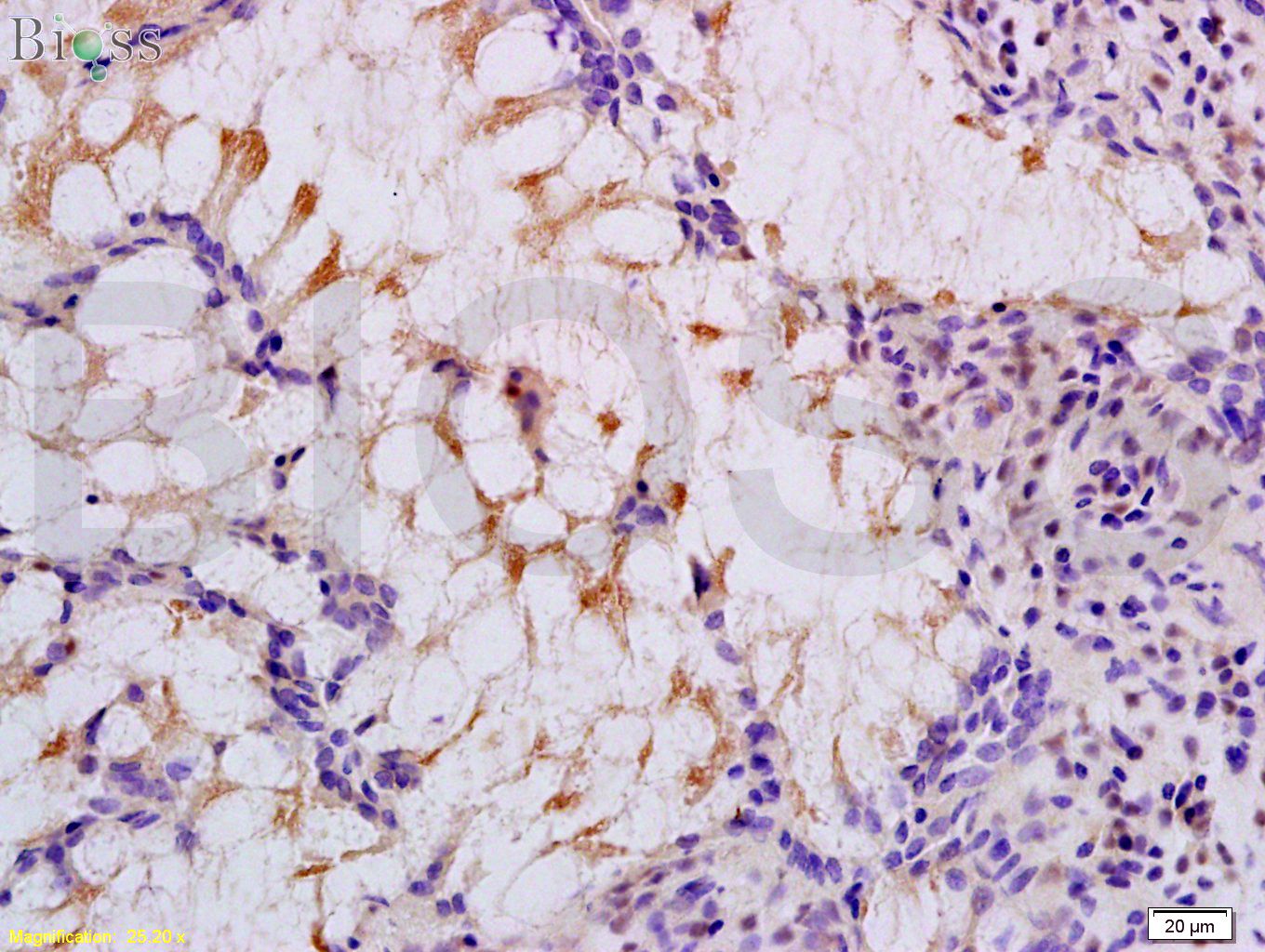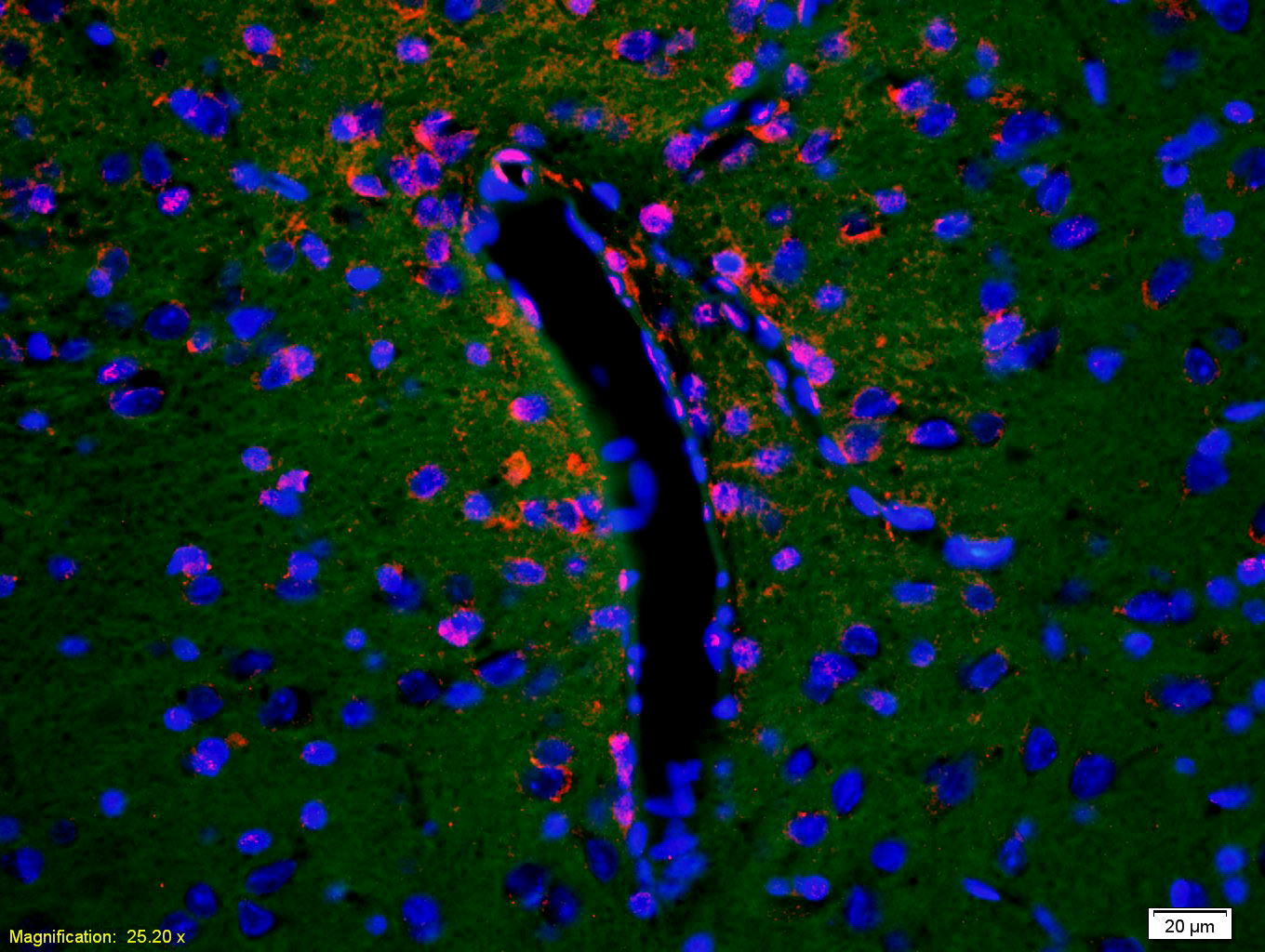
Rabbit Anti-MMP14 antibody
MMP 14; MMP-14; Membrane-type matrix metalloproteinase 1; MT-MMP 1; MTMMP1; Membrane-type-1 matrix metalloproteinase; MT1-MMP; MT1MMP; MMP-X1; MT-MMP; MMP14_HUMAN.
View History [Clear]
Details
Product Name MMP14 Chinese Name 基质金属蛋白酶-14抗体 Alias MMP 14; MMP-14; Membrane-type matrix metalloproteinase 1; MT-MMP 1; MTMMP1; Membrane-type-1 matrix metalloproteinase; MT1-MMP; MT1MMP; MMP-X1; MT-MMP; MMP14_HUMAN. Research Area Tumour Cell biology Neurobiology Signal transduction Apoptosis Cytoskeleton Extracellular matrix Immunogen Species Rabbit Clonality Polyclonal React Species Human, Rat, (predicted: Mouse, Pig, Sheep, ) Applications ELISA=1:5000-10000 IHC-P=1:100-500 IHC-F=1:100-500 IF=1:100-500 (Paraffin sections need antigen repair)
not yet tested in other applications.
optimal dilutions/concentrations should be determined by the end user.Theoretical molecular weight 54/62kDa Cellular localization The cell membrane Form Liquid Concentration 1mg/ml immunogen KLH conjugated synthetic peptide derived from human MMP14: 271-370/582 <Extracellular> Lsotype IgG Purification affinity purified by Protein A Buffer Solution 0.01M TBS(pH7.4) with 1% BSA, 0.03% Proclin300 and 50% Glycerol. Storage Shipped at 4℃. Store at -20 °C for one year. Avoid repeated freeze/thaw cycles. Attention This product as supplied is intended for research use only, not for use in human, therapeutic or diagnostic applications. PubMed PubMed Product Detail The matrix metalloproteinases (MMPs) are a family of at least eighteen secreted and membrane bound zincendopeptidases. Collectively, these enzymes can degrade all the components of the extracellular matrix, including fibrillar and non fibrillar collagens, fibronectin, laminin and basement membrane glycoproteins. In general, a signal peptide, a propeptide, and a catalytic domain containing the highly conserved zinc binding site characterizes the structure of the MMPs. In addition, fibronectin like repeats, a hinge region, and a C terminal hemopexin like domain allow categorization of MMPs into the collagenase, gelatinase, stomelysin and membrane-type MMP subfamilies. All MMPs are synthesized as proenzymes, and most of them are secreted from the cells as proenzymes. Thus, the activation of these proenzymes is a critical step that leads to extracellular matrix breakdown. MMPs are considered to play an important role in wound healing, apoptosis, bone elongation, embryo development, uterine involution, angiogenesis and tissue remodeling, and in diseases such as multiple sclerosis, Alzheimer's, malignant gliomas, lupus, arthritis, periodontis, glumerulonephritis, atherosclerosis, tissue ulceration, and in cancer cell invasion and metastasis.
MMP14 may be an activator of pro gelatinase A and is expressed in fibroblast cells during both wound healing and human cancer progression. MMP14 is expressed in very low levels and may require stimulation with concanavolin A or the phorbol ester TPA to stimulate production of MMP14.
Matrix metalloproteinase-14 precursor is endopeptidase that degrades various components of the extracellular matrix, such as collagen. Activates progelatinase A. Essential for pericellular collagenolysis and modeling of skeletal and extraskeletal connective tissues during development. [Catalytic activity] Endopeptidase activity. Activates progelatinase A by cleavage of the propeptide at 37-Asn-|-Leu-38. Other bonds hydrolyzed include 35-Gly-|-Ile-36 in the propeptide of collagenase 3, and 341-Asn-|-Phe-342, 441-Asp-|-Leu-442 and 354-Gln-|-Thr-355 in the aggrecan interglobular domain. Highly expressed in placenta, kidney, heart, lung, embryonic skeletal and periskeletal tissues. Belongs to the peptidase M10A family.
Function:
Seems to specifically activate progelatinase A. May thus trigger invasion by tumor cells by activating progelatinase A on the tumor cell surface. May be involved in actin cytoskeleton reorganization by cleaving PTK7.
Subcellular Location:
Membrane; Single-pass type I membrane protein (Potential). Melanosome. Note=Identified by mass spectrometry in melanosome fractions from stage I to stage IV.
Tissue Specificity:
Expressed in stromal cells of colon, breast, and head and neck. Expressed in lung tumors.
Post-translational modifications:
The precursor is cleaved by a furin endopeptidase.
Similarity:
Belongs to the peptidase M10A family.
Contains 4 hemopexin-like domains.
SWISS:
Q9BGL3
Gene ID:
4323
Database links:Entrez Gene: 4323 Human
Entrez Gene: 17387 Mouse
Omim: 600754 Human
SwissProt: P50281 Human
SwissProt: P53690 Mouse
Unigene: 2399 Human
Unigene: 280175 Mouse
Unigene: 10371 Rat
Product Picture
Antigen retrieval: citrate buffer ( 0.01M, pH 6.0 ), Boiling bathing for 15min; Block endogenous peroxidase by 3% Hydrogen peroxide for 30min; Blocking buffer (normal goat serum,C-0005) at 37℃ for 20 min;
Incubation: Anti-MMP-14 Polyclonal Antibody, Unconjugated(SL0414R) 1:200, overnight at 4°C, followed by conjugation to the secondary antibody(SP-0023) and DAB(C-0010) staining
Tissue/cell: rat brain tissue;4% Paraformaldehyde-fixed and paraffin-embedded;
Antigen retrieval: citrate buffer ( 0.01M, pH 6.0 ), Boiling bathing for 15min; Blocking buffer (normal goat serum,C-0005) at 37℃ for 20 min;
Incubation: Anti-MMP-14 Polyclonal Antibody, Unconjugated(SL0414R) 1:200, overnight at 4°C; The secondary antibody was Goat Anti-Rabbit IgG, Cy3 conjugated(SL0295G-Cy3)used at 1:200 dilution for 40 minutes at 37°C. DAPI(5ug/ml,blue,C-0033) was used to stain the cell nuclei
Partial purchase records(bought amounts latest0)
No one bought this product
User Comment(Total0User Comment Num)
- No comment




 +86 571 56623320
+86 571 56623320




